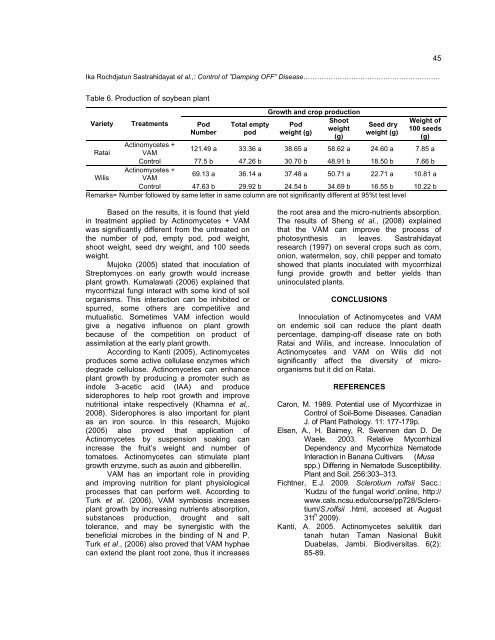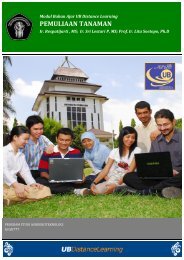CONTROL OF “DAMPING OFF” DISEASE CAUSED BY Sclerotium ...
CONTROL OF “DAMPING OFF” DISEASE CAUSED BY Sclerotium ...
CONTROL OF “DAMPING OFF” DISEASE CAUSED BY Sclerotium ...
You also want an ePaper? Increase the reach of your titles
YUMPU automatically turns print PDFs into web optimized ePapers that Google loves.
Ika Rochdjatun Sastrahidayat et al.,: Control of ”Damping <strong>OF</strong>F” Disease……………………………………………………<br />
Table 6. Production of soybean plant<br />
Variety Treatments Pod<br />
Number<br />
Total empty<br />
pod<br />
Growth and crop production<br />
Pod<br />
weight (g)<br />
Shoot<br />
weight<br />
(g)<br />
Seed dry<br />
weight (g)<br />
45<br />
Weight of<br />
100 seeds<br />
(g)<br />
Ratai<br />
Actinomycetes +<br />
VAM<br />
121.49 a 33.36 a 38.65 a 58.62 a 24.60 a 7.85 a<br />
Control 77.5 b 47.26 b 30.70 b 48.91 b 18.50 b 7.66 b<br />
Wilis<br />
Actinomycetes +<br />
VAM<br />
69.13 a 36.14 a 37.48 a 50.71 a 22.71 a 10.81 a<br />
Control 47.63 b 29.92 b 24.54 b 34.69 b 16.55 b 10.22 b<br />
Remarks= Number followed by same letter in same column are not significantly different at 95%t test level<br />
Based on the results, it is found that yield<br />
in treatment applied by Actinomycetes + VAM<br />
was significantly different from the untreated on<br />
the number of pod, empty pod, pod weight,<br />
shoot weight, seed dry weight, and 100 seeds<br />
weight.<br />
Mujoko (2005) stated that inoculation of<br />
Streptomyces on early growth would increase<br />
plant growth. Kumalawati (2006) explained that<br />
mycorrhizal fungi interact with some kind of soil<br />
organisms. This interaction can be inhibited or<br />
spurred, some others are competitive and<br />
mutualistic. Sometimes VAM infection would<br />
give a negative influence on plant growth<br />
because of the competition on product of<br />
assimilation at the early plant growth.<br />
According to Kanti (2005), Actinomycetes<br />
produces some active cellulase enzymes which<br />
degrade cellulose. Actinomycetes can enhance<br />
plant growth by producing a promoter such as<br />
indole 3-acetic acid (IAA) and produce<br />
siderophores to help root growth and improve<br />
nutritional intake respectively (Khamna et al,.<br />
2008). Siderophores is also important for plant<br />
as an iron source. In this research, Mujoko<br />
(2005) also proved that application of<br />
Actinomycetes by suspension soaking can<br />
increase the fruit’s weight and number of<br />
tomatoes. Actinomycetes can stimulate plant<br />
growth enzyme, such as auxin and gibberellin.<br />
VAM has an important role in providing<br />
and improving nutrition for plant physiological<br />
processes that can perform well. According to<br />
Turk et al. (2006), VAM symbiosis increases<br />
plant growth by increasing nutrients absorption,<br />
substances production, drought and salt<br />
tolerance, and may be synergistic with the<br />
beneficial microbes in the binding of N and P.<br />
Turk et al., (2006) also proved that VAM hyphae<br />
can extend the plant root zone, thus it increases<br />
the root area and the micro-nutrients absorption.<br />
The results of Sheng et al., (2008) explained<br />
that the VAM can improve the process of<br />
photosynthesis in leaves. Sastrahidayat<br />
research (1997) on several crops such as corn,<br />
onion, watermelon, soy, chili pepper and tomato<br />
showed that plants inoculated with mycorrhizal<br />
fungi provide growth and better yields than<br />
uninoculated plants.<br />
CONCLUSIONS<br />
Innoculation of Actinomycetes and VAM<br />
on endemic soil can reduce the plant death<br />
percentage, damping-off disease rate on both<br />
Ratai and Wilis, and increase. Innoculation of<br />
Actinomycetes and VAM on Wilis did not<br />
significantly affect the diversity of microorganisms<br />
but it did on Ratai.<br />
REFERENCES<br />
Caron, M. 1989. Potential use of Mycorrhizae in<br />
Control of Soil-Borne Diseases. Canadian<br />
J. of Plant Pathology. 11: 177-179p.<br />
Elsen, A., H. Baimey, R. Swennen dan D. De<br />
Waele. 2003. Relative Mycorrhizal<br />
Dependency and Mycorrhiza Nematode<br />
Interaction in Banana Cultivars (Musa<br />
spp.) Differing in Nematode Susceptibility.<br />
Plant and Soil. 256:303–313.<br />
Fichtner, E.J. 2009. <strong>Sclerotium</strong> rolfsii Sacc.:<br />
‘Kudzu of the fungal world’.online, http://<br />
www.cals.ncsu.edu/course/pp728/<strong>Sclerotium</strong>/S.rolfsii<br />
.html, accesed at August<br />
31t h 2009).<br />
Kanti, A. 2005. Actinomycetes selulitik dari<br />
tanah hutan Taman Nasional Bukit<br />
Duabelas, Jambi. Biodiversitas. 6(2):<br />
85-89.




